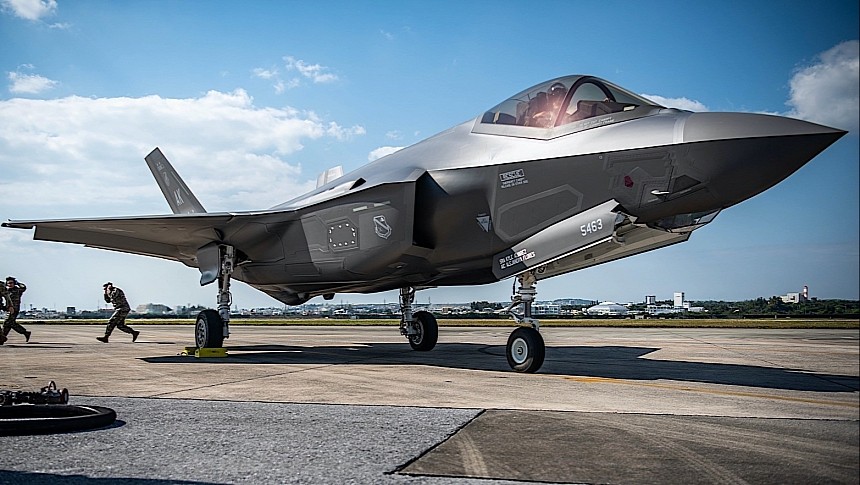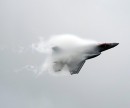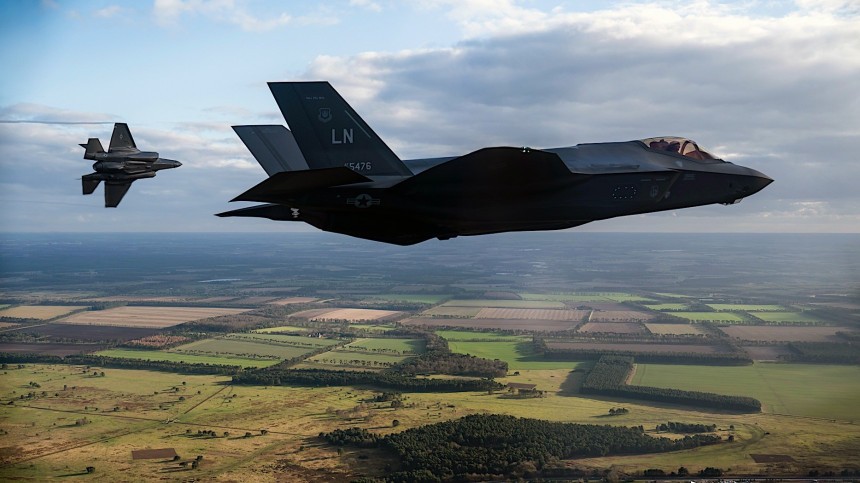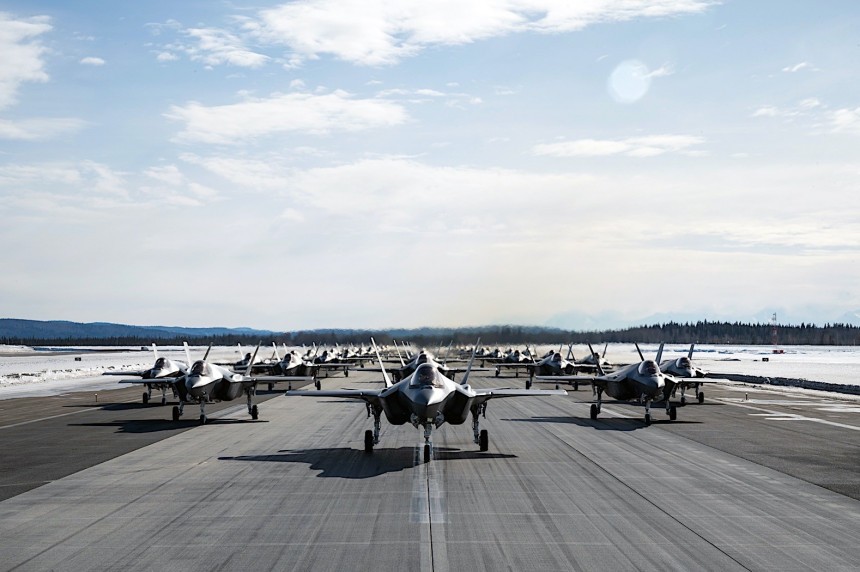Last month, the mighty United States Air Force's 187th Fighter Wing based in Dannely Field, Alabama, played host to a nation that, at one time, was an ideological adversary to the U.S. many years ago. But three decades after the fall of communism, it's clear that global affairs are far different nowadays, as the 187th welcomed Lt. Gen. Viorel Pana, Chief of the Romanian Air Force Staff, for a tour of the Montgomery Air National Guard Base. But a geo-political odd coupling, this meeting was not. Quite the opposite, in fact.
You see, the Romanian Air Force is on a mission from the heavens. Or, at least, it feels that way with the kinds of major moves they've been making lately. With a hostile and violently dangerous military operation taking place right next door to Romania in Ukraine, key Air Force officials like Lt. General Pana are gearing up to revitalize his nation's aircraft to not just be on par with the likes of Russia but even its fellow NATO allies. They plan to use cutting-edge American hardware to make it happen. But it's not a process that will take place overnight, far from it. To understand how Romania's Air Force found itself in the position it is today, one must know the full story behind military aviation in Romania.
Indeed, most av-geeks know in the early days of human flight, much of the world's aviation know-how was concentrated in one of two spots. Either the Hempstead Plains of Long Island, New York, or the grassy fields of the suburban outskirts of Paris. But mixed in with the world's first major aviation hubs was a consortium of ethnic Romanians who proved Eastern Europe had a place in the global aerospace sector. Even before modern-day Western Romania was formally annexed from the fallen Austro-Hungarian Empire, pioneers like Aurel Vlaicu, Henri Coanda, and Traian Vuia were taking to the skies in what was, at the time, very highly advanced airplanes with novel features like fixed landing gears.
Traian Vuia, especially was noted for constructing airplanes far more in line with a modern-day form factor than anything built by the Wright Brothers in their early days. With the Romanian Air Corps getting their first taste of combat in 1916 during World War I, the country was in a prime position to become an aeronautical powerhouse of Eastern Europe. Using permission from the French to make license-built copies of their own domestic aircraft, famous names in Romanian aviation like the SET and IAR companies found their start during this precarious inter-war period from the late 1910s until the late 1930s.
During World War II, the biggest Romanian contribution to aviation was the IAR-80/81 single-engine fighter. Itself a re-engineering of a Polish design from the manufacturer PZL, with various other fighters and light bombers via their allyship with the Germans. But it was only after the invasion of Romania by the Soviets in August 1944 that the country's aviation sector once again found itself in a state of profound change. No longer would Romania have the benefit of healthy working relationships with Western airplane manufacturing nations like France. Rather, Romania would spend the years between 1947 and 1991 reliant on Soviet imports to account for a great deal of its military air power.
Recognizable Soviet jet fighters like the Yakovlev Yak-23, the Czech Aero L-29 Delphin, and the Mikoyan-Gurevich MiG-19 and MiG-21 came to define the Romanian Air Force as the nation came under the rule of its totalitarian communist dictator Nicolae Ceau?escu in the mid-1960s. In the following decade, Romania collaborated closely with Yugoslavia to manufacture the IAR-93 Vultur ground attack jet and its Yugoslav cousin, the Soko J-22 Orao, as well as the country's first native jet, the IAR-99 trainer. As the Romanian-Soviet split took shape in the 60s and 70s, Romania was able to once again manufacture French helicopters from Aerospatiale to create the IAR-316 and 330.
Even so, the Romanian Air Force would not receive a comprehensive upgrade until after the anti-communist revolution of 1989. The nation received its first shipment of MiG-29 gen-IV jet fighter that same year, though Romanian pilots chose to retire these jets in favor of upgrading their fleet of MiG-21s into the LanceR series with help from Israel in 2003. That very next year, Romania joined NATO. Thus setting in motion a series of events that culminated at Dannelly Field this past month, as Romanian Air Force personnel met with their USAF counterparts to discuss Romania's acquisition of the F-35 Lightning II Joint Strike Fighter by the beginning of the 2030s.
Indeed, the Alabama Air National Guard and the Romanian Air Force have had a somewhat special relationship ever since the fall of communism. The AANG was instrumental in helping Romanian pilots come to grips with a NATO stalwart fighter, the F-16 Fighting Falcon, after they'd been acquired from Norway and Portugal, respectively. With a formal deal between Romania and Lockheed Martin to procure F-35s in the near future, signed in April 2023, it appears that the 187th Fighter Wing and the Romanian Air Force will undergo the very same transition simultaneously as the "Red Tails" gear up to fly the very same jet soon.
"It will be our 30-year anniversary with the State Partnership Program with Romania. Quality assurance senior enlisted leader. "It is always a blessing to see people you have grown with over your career. It truly is like a family reunion when we get together," said Chief Master Sgt. William Rhodes. This sentiment was paralleled by the 187th's Fighter Wing Commander Col Brian Vaughn. "Showing our conversion process will provide our state partners with firsthand experience on what is needed to support one of the most advanced aircraft in the Air Force. Working with Romania and sharing lessons learned with some of the best is always an amazing experience. We look forward to any opportunity that will allow us to strengthen our bond through joint operations, as we have done for three decades. Our ability to continue to operate globally will depend on our relationships, and these partners have long-standing connections that we value greatly."
As of July 2023, Lockheed Martin expects to deliver its 1000th F-35 Lightning II airframe by the end of the year. With backorders still to be fulfilled for a host of NATO-aligned Air Forces and its allies like Israel, Australia, and Finland, it could still be quite some time before Romanian pilots take the stick of a shiny, new American gen-V stealth fighter. In the meantime, there's plenty of time for Romanian pilots to get the hang of their pending new jets behind the stick in American combat simulators.
Indeed, most av-geeks know in the early days of human flight, much of the world's aviation know-how was concentrated in one of two spots. Either the Hempstead Plains of Long Island, New York, or the grassy fields of the suburban outskirts of Paris. But mixed in with the world's first major aviation hubs was a consortium of ethnic Romanians who proved Eastern Europe had a place in the global aerospace sector. Even before modern-day Western Romania was formally annexed from the fallen Austro-Hungarian Empire, pioneers like Aurel Vlaicu, Henri Coanda, and Traian Vuia were taking to the skies in what was, at the time, very highly advanced airplanes with novel features like fixed landing gears.
Traian Vuia, especially was noted for constructing airplanes far more in line with a modern-day form factor than anything built by the Wright Brothers in their early days. With the Romanian Air Corps getting their first taste of combat in 1916 during World War I, the country was in a prime position to become an aeronautical powerhouse of Eastern Europe. Using permission from the French to make license-built copies of their own domestic aircraft, famous names in Romanian aviation like the SET and IAR companies found their start during this precarious inter-war period from the late 1910s until the late 1930s.
During World War II, the biggest Romanian contribution to aviation was the IAR-80/81 single-engine fighter. Itself a re-engineering of a Polish design from the manufacturer PZL, with various other fighters and light bombers via their allyship with the Germans. But it was only after the invasion of Romania by the Soviets in August 1944 that the country's aviation sector once again found itself in a state of profound change. No longer would Romania have the benefit of healthy working relationships with Western airplane manufacturing nations like France. Rather, Romania would spend the years between 1947 and 1991 reliant on Soviet imports to account for a great deal of its military air power.
Even so, the Romanian Air Force would not receive a comprehensive upgrade until after the anti-communist revolution of 1989. The nation received its first shipment of MiG-29 gen-IV jet fighter that same year, though Romanian pilots chose to retire these jets in favor of upgrading their fleet of MiG-21s into the LanceR series with help from Israel in 2003. That very next year, Romania joined NATO. Thus setting in motion a series of events that culminated at Dannelly Field this past month, as Romanian Air Force personnel met with their USAF counterparts to discuss Romania's acquisition of the F-35 Lightning II Joint Strike Fighter by the beginning of the 2030s.
Indeed, the Alabama Air National Guard and the Romanian Air Force have had a somewhat special relationship ever since the fall of communism. The AANG was instrumental in helping Romanian pilots come to grips with a NATO stalwart fighter, the F-16 Fighting Falcon, after they'd been acquired from Norway and Portugal, respectively. With a formal deal between Romania and Lockheed Martin to procure F-35s in the near future, signed in April 2023, it appears that the 187th Fighter Wing and the Romanian Air Force will undergo the very same transition simultaneously as the "Red Tails" gear up to fly the very same jet soon.
"It will be our 30-year anniversary with the State Partnership Program with Romania. Quality assurance senior enlisted leader. "It is always a blessing to see people you have grown with over your career. It truly is like a family reunion when we get together," said Chief Master Sgt. William Rhodes. This sentiment was paralleled by the 187th's Fighter Wing Commander Col Brian Vaughn. "Showing our conversion process will provide our state partners with firsthand experience on what is needed to support one of the most advanced aircraft in the Air Force. Working with Romania and sharing lessons learned with some of the best is always an amazing experience. We look forward to any opportunity that will allow us to strengthen our bond through joint operations, as we have done for three decades. Our ability to continue to operate globally will depend on our relationships, and these partners have long-standing connections that we value greatly."

























